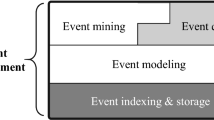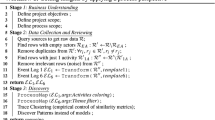Summary
The most fundamental causes may be hidden and in severe cases unknown (not in the knowledge of a human nor a computer). These causal events might be occurring eternally, or be brought up from a sequence in the past and trigger events in the future. Here is presented KeyGraph, generalized from a document-indexing method to a method for extracting essential events and the causal structures among them from an event sequence.
Access this chapter
Tax calculation will be finalised at checkout
Purchases are for personal use only
Preview
Unable to display preview. Download preview PDF.
Similar content being viewed by others
References
Granovetter M (1973) Strength of Weak Ties,American Journal of Sociology, 8: 13601380
Greenacre MJ (1984) Theory and applications of correspondence analysis. Academic Press, London, UK
International Human Genome Sequencing Consortium (2001) Initial sequencing and analysis of the human genome,Nature, 409: 860–921
Ohsawa Y, Benson NE, Yachida M (1998) KeyGraph: Automatic Indexing by Cooccurrence Graph Based on Building Construction Metaphor,Proceedings of Advances in Digital Libraries Conference, pp. 12–18
Ohsawa Y, Yachida M (1999) Discover Risky Active Faults by Indexing an Earthquake Sequence, Proceedings of Discovery Science, Springer Verlag, Heidelberg, Germany, pp. 208–219
Ohsawa Y (1999) Get Timely Files from Visualized Structure of Your Working History,Proceedings of the 3rd Knowledge-Based Intelligent Engineering Systems & Allied Technologies, pp.546–549
Ohsawa Y, Fukuda H (2002) Potential Motivations and Fountains of Chances,Journal of Contingencies and Crisis Management, 10(3):129–138
Venter JC (2001) The Sequence of the Human Genome,Science, 291:1304–1351
Yamada S, Osawa Y (2000) Navigation Planning to Guide Concept Understanding in the World Wide Web,Proceedings of Autonomous Agents, pp. 114–115.
Author information
Authors and Affiliations
Editor information
Editors and Affiliations
Rights and permissions
Copyright information
© 2003 Springer-Verlag Berlin Heidelberg
About this chapter
Cite this chapter
Ohsawa, Y. (2003). KeyGraph: Visualized Structure Among Event Clusters. In: Ohsawa, Y., McBurney, P. (eds) Chance Discovery. Advanced Information Processing. Springer, Berlin, Heidelberg. https://doi.org/10.1007/978-3-662-06230-2_18
Download citation
DOI: https://doi.org/10.1007/978-3-662-06230-2_18
Publisher Name: Springer, Berlin, Heidelberg
Print ISBN: 978-3-642-05609-3
Online ISBN: 978-3-662-06230-2
eBook Packages: Springer Book Archive




